- Blog >
- WHAT IS NDT (NON-DESTRUCTIVE TESTING)?
WHAT IS NDT (NON-DESTRUCTIVE TESTING)?
NDT refers to an array of inspection techniques that allow inspectors to collect data about a material without damaging it.
NDT stands for Non-Destructive Testing. It refers to an array of inspection methods that allow inspectors to evaluate and collect data about a material, system, or component without permanently altering it.
In the field, NDT is often used as an umbrella term to refer to non-destructive inspection methods, inspection tools, or even the entire field of non-destructive inspections.
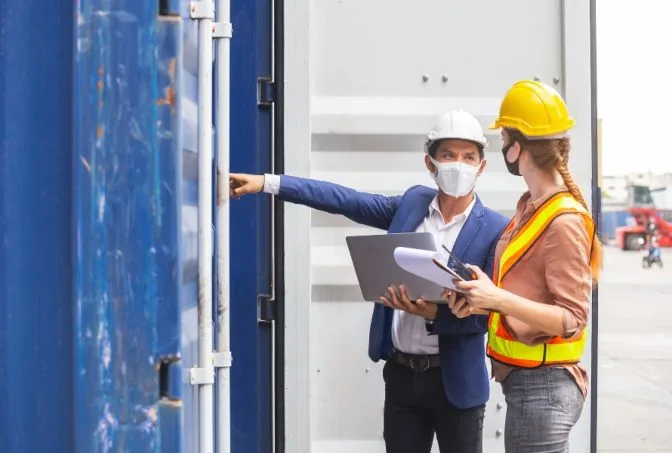
For commercial applications, the goal of NDT is to ensure that critical infrastructure is properly maintained in order to avoid catastrophic accidents.
While NDT methods are typically associated with industrial use cases, like inspecting weak points in a boiler at an oil refinery, uses in medicine are actually some of the most common.
For example, an expecting mother getting an ultrasound to check on the health of her baby would be considered an NDT use case, as would getting an X-ray or MRI to learn more about an injury.
But it’s important to note that NDT does not necessarily require the use of special tools, or any tools at all.
For instance, when inspectors in industrial settings review the outside of a pressure vessel with their naked eye, that would fall under the NDT designation, since they are collecting data on the status of the boiler without damaging it. On the other hand, using a sophisticated tool like an ultrasonic sensor to look for defects in a certain material or asset would also be called NDT.
Regardless of the specific use case, the underlying commonality among all these examples is the collection of data in a non-intrusive manner.
What Is NDT?
We’ve already covered what NDT stands for and how the phrase is used in the field. Now let’s dive in and look more closely at some of the details that govern the world of NDT.
The Importance of NDT
When it comes to ensuring that assets are properly maintained, the importance of non-destructive testing cannot be over emphasized.
Here are the top reasons NDT is used by so many companies throughout the world:
-
Savings. The most obvious answer to this question is that NDT is more appealing than destructive testing because it allows the material or object being examined to survive the examination unharmed, thus saving money and resources.
-
Safety. NDT is also appealing because almost all NDT techniques (except radiographic testing) are harmless to people.
-
Efficiency. NDT methods allow for the thorough and relatively quick evaluation of assets, which can be crucial for ensuring continued safety and performance on a job site.
-
Accuracy. NDT methods have been proven accurate and predictable, both qualities you want when it comes to maintenance procedures meant to ensure the safety of personnel and the longevity of equipment.
"NDT is the life blood of a well-run facility, and the high importance of NDT is known by any trained inspector. NDT techniques and repeatable results depend on highly trained technicians with experience and integrity. Not only does the technician need to be certified in a specific NDT method, but they also need to know how to operate the equipment being used to gather data. Understanding equipment capabilities and limitations is the difference between making an accept or reject determination."
- Jason Acerbi, General Manager at MFE Inspection Solutions, "Your One Stop Inspection Source"
Where is NDT Used?
Depending on how broadly you define NDT you could say that it’s used in almost every industry in the world, since visual inspections (whether formalized or casual) take place in almost every workplace in some form or other.
That being said, there are specific industries that require NDT and have formalized processes for its use, as codified by those organizations we listed above like API and ASME.
These industries include:
-
Oil & Gas
-
Power Generation
-
Chemicals
-
Mining
-
Aerospace
-
Automotive
-
Maritime
-
Mining
In all of these industries, there are three different methods that inspectors use to gain access to hard-to-reach locations or locations at height:
-
Scaffolding. The use of scaffolding requires inspectors to work at height in person in order to collect inspection data.
-
Rope access. The use of rope access also requires inspectors to work at height in order to collect inspection data.
-
Drones. Inspectors can use drones to collect inspection data remotely, allowing them to remain safely outside of confined spaces or safely below locations at height. Read the next section to learn more about how drones can be used for NDT.
NDT Codes and Standards
NDT techniques can be used for all kinds of inspections. But some of the most important types of NDT inspections are of assets like boilers and pressure vessels, which could be incredibly dangerous if not properly maintained.
Because proper maintenance of these assets is so important for the safety of those working nearby (or even at a distance, when it comes to nuclear power plants), most countries have laws requiring companies to adhere to specific inspection codes and standards when conducting inspections.
These standards and codes typically require inspections to be conducted periodically following specific guidelines. For the most assets that present the greatest risk, these inspections must be both conducted by a certified inspector and approved by a certified witness working for a formal inspection body.
Here are the most commonly followed organizations in the world for creating NDT standards and codes:
-
API (American Petroleum Institute)
-
ASME (American Society for Mechanical Engineers)
-
ASTM (American Society for Testing and Materials)
-
ASNT (American Society For Nondestructive Testing)
-
COFREND (French Committee for Non-destructive Testing Studies)
-
CSA Group (Canadian Standards Association)
-
CGSB (Canadian General Standards Board)
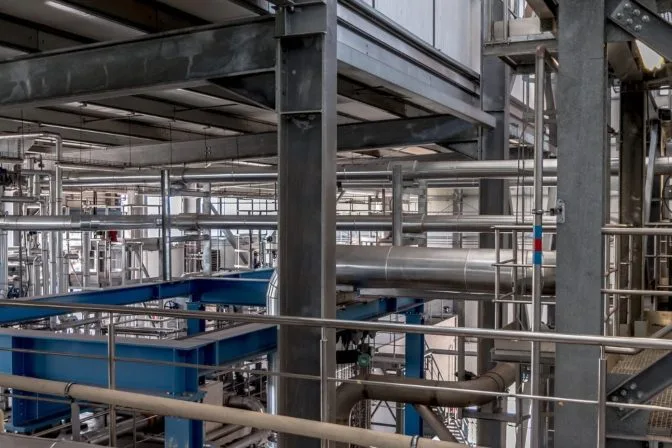
What Is the Difference Between Destructive Testing and Non-Destructive Testing?
Non-Destructive Testing (NDT) is used to collect information about a material in ways that do not alter it (i.e., without destroying it). Destructive Testing (DT) is used to collect information about a material in ways that do alter it (i.e., destroy it).
Essentially, the NDT and DT difference is that NDT doesn't require inspectors to damage the material they test, while DT does.
In Destructive Testing, for example, a piece of the material might be scraped away for analysis or altered in some other way onsite.
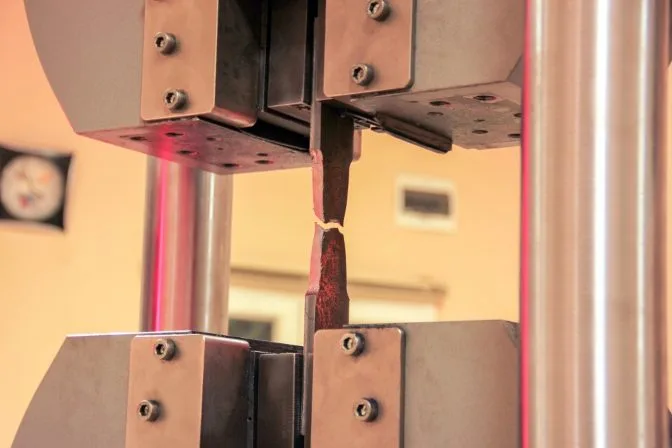
Here are some examples of destructive testing:
-
Macro sectioning. Macro sectioning tests a small section of a welded material by polishing and etching it for examination.
-
Tensile testing. Also called tension testing, this is a destructive testing technique that uses controlled tension applied to a sample material to see how it reacts. Tension could be applied to test certain loads or conditions, or to test a material’s failure point.
-
3 point bend testing. 3 point bend testing examines the soundness and flexibility (or ductility) of a material by taking a sample of it, called a coupon, and bending it in three points to a specified angle.
NDT and NDE
While we're defining terms, it's important to note that there are a few common phrases that refer to testing materials without destroying them.
NDT is the most common phrase, but there are a few others as well:
-
NDE (non-destructive examination or non-destructive evaluation)
-
NDI (non-destructive inspection)
The NDE full form is non-destructive examination or non-destructive evaluation, and the NDI full form is non-destructive inspection.
The 8 Most Common NDT Methods
There are several techniques used in NDT and NDE for the collection of various types of data, each requiring its own kind of tools, training, and preparation.
Some of these techniques might allow for a complete volumetric inspection of an object, while others only allow for a surface inspection. In a similar way, some NDT methods will have varying degrees of success depending on the type of material they’re used on, and some techniques—such as Magnetic Particle NDT, for example—will only work on specific materials (i.e., those that can be magnetized).
Here are the eight most commonly used NDT techniques:
1. Visual Testing (VT)
Definition: Visual Non-Destructive Testing is the act of collecting visual data on the status of a material. Visual Testing is the most basic way to examine a material or object without altering it in any way.
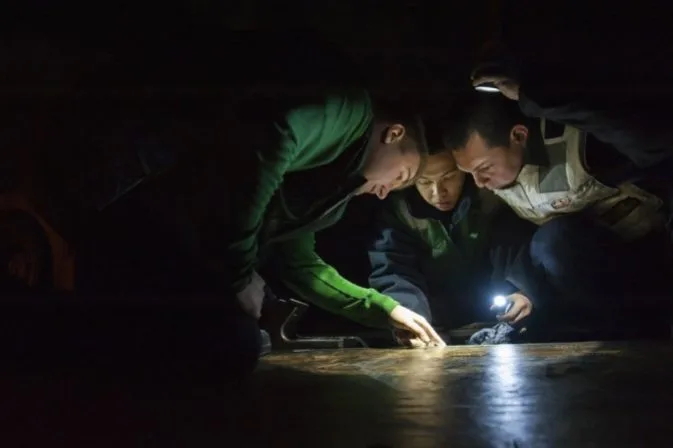
How to Conduct Visual Testing
Visual Testing can be done with the naked eye, by inspectors visually reviewing a material or asset. For indoor Visual Testing, inspectors use flashlights to add depth to the object being examined. Visual Testing can also be done with an RVI (Remote Visual Inspection) tool, like an inspection camera. To get the camera in place, NDT inspectors may use a robot or drone, or may simply hang it from a rope.
2. Ultrasonic Testing (UT)
Definition: Ultrasonic Non-Destructive Testing is the process of transmitting high-frequency sound waves into a material in order to identify changes in the material’s properties.
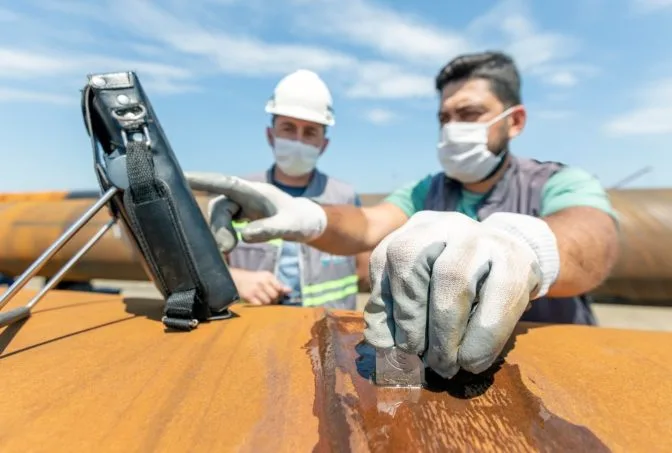
How to Conduct Ultrasonic Testing
In general, Ultrasonic Testing uses sound waves to detect defects or imperfections on the surface of a material created.
One of the most common Ultrasonic Testing methods is the pulse echo. With this technique, inspectors introduce sounds into a material and measure the echos (or sound reflections) produced by imperfections on the surface of the material as they are returned to a receiver.
Here are some other types of Ultrasonic Testing:
-
Phased Array Ultrasonic Testing (PAUT)
-
Automated Ultrasonic Testing (AUT)
-
Time-Of-Flight Diffraction (TOFD)
Read our guide on ultrasonic testing.
3. Radiography Testing (RT)
Definition: Radiography Non-Destructive Testing is the act of using gamma- or X-radiation on materials to identify imperfections.
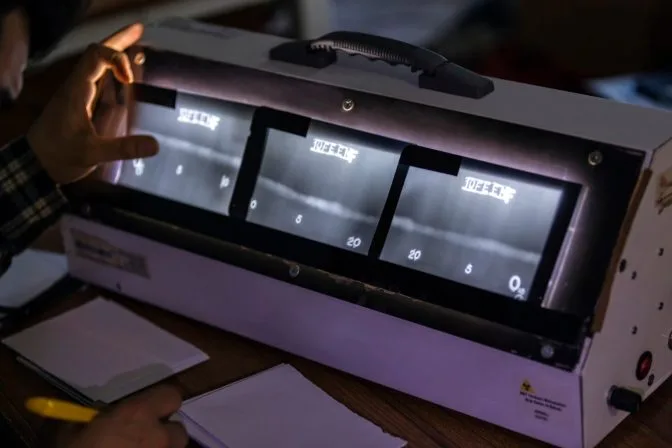
How to Conduct Radiography NDT Testing
Radiography Testing directs radiation from a radioactive isotope or an X-ray generator through the material being tested and onto a film or some other kind of detector. The readings from the detector create a shadowgraph, which reveals the underlying aspects of the inspected material.
Radiography Testing can uncover aspects of a material that can be hard to detect with the naked eye, such as alterations to its density.
4. Eddy Current (Electromagnetic) Testing (ET)
Definition: Eddy Current Non-Destructive Testing is a type of electromagnetic testing that uses measurements of the strength of electrical currents (also called eddy currents) in a magnetic field surrounding a material in order to make determinations about the material, which may include the locations of defects.
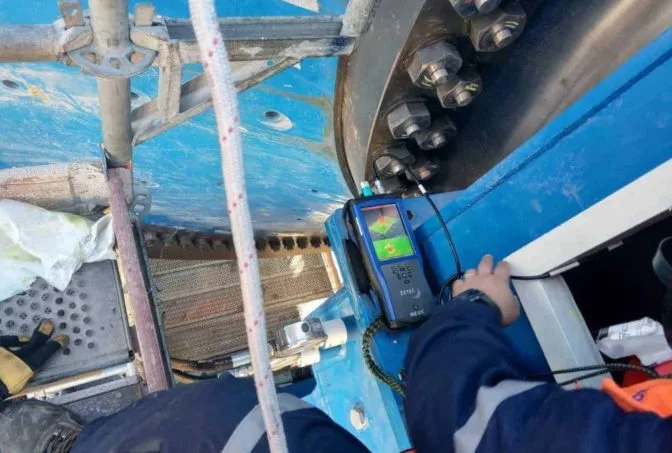
How to Conduct Eddy Current Testing
To conduct Eddy Current Testing, inspectors examine the flow of eddy currents in the magnetic field surrounding a conductive material to identify interruptions caused by defects or imperfections in the material.
5. Magnetic Particle Inspection (MPI)
Definition: Magnetic Particle Non-Destructive Testing is the act of identifying imperfections in a material by examining disruptions in the flow of the magnetic field within the material.
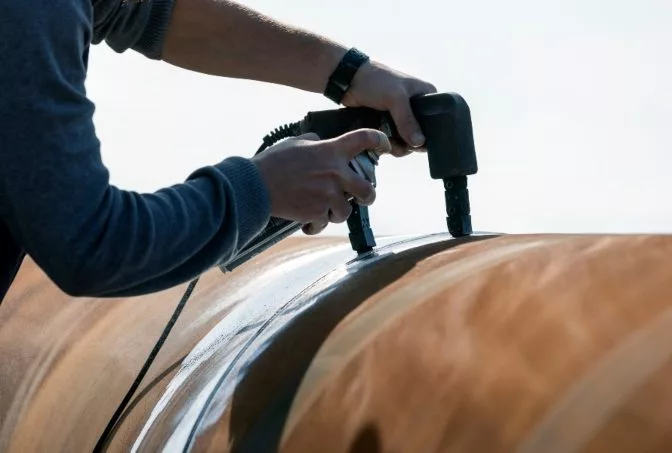
How to Conduct Magnetic Particle Inspection
To use Magnetic Particle Inspection, inspectors first induce a magnetic field in a material that is highly susceptible to magnetization. After inducing the magnetic field, the surface of the material is then covered with iron particles, which reveal disruptions in the flow of the magnetic field. These disruptions create visual indicators for the locations of imperfections within the material.
6. Acoustic Emission Testing (AE)
Definition: Acoustic Emission Non-Destructive Testing is the act of using acoustic emissions to identify possible defects and imperfections in a material.

How to Conduct Acoustic Emission Testing
Inspectors conducting Acoustic Emission Tests are examining materials for bursts of acoustic energy, also called acoustic emissions, which are caused by defects in the material. Intensity, location, and arrival time can be examined to reveal information about possible defects within the material.
7. Dye Penetrant testing (PT)
Definition: Dye Penetrant Penetrant Non-Destructive Testing (also called Liquid Penetrant Testing) refers to the process of using a liquid to coat a material and then looking for breaks in the liquid to identify imperfections in the material.
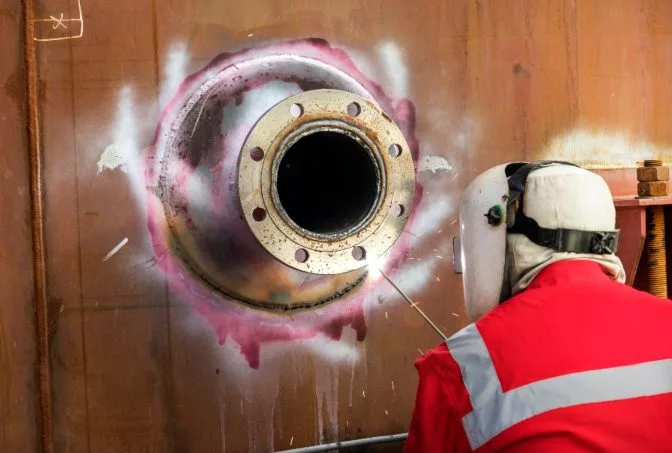
How to Conduct Penetrant Testing
Inspectors conducting a Penetrant Test will first coat the material being tested with a solution that contains a visible or fluorescent dye. Inspectors then remove any extra solution from the material’s surface while leaving the solution in defects that “break” the material’s surface.
After this, inspectors use a developer to draw the solution out of the defects, then use ultraviolet light to reveal imperfections (for fluorescent dyes). For regular dyes, the color shows in the contrast between the penetrant and the developer.
8. Leak Testing (LT)
Definition: Leak Non-Destructive Testing refers to the process of studying leaks in a vessel or structure in order to identify defects in it.
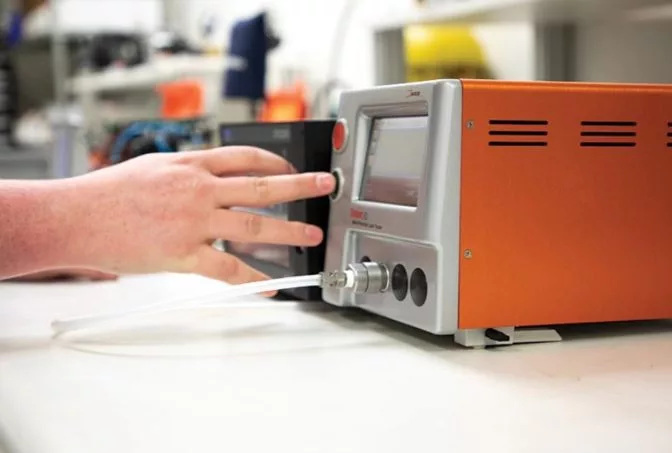
How to Conduct Leak Testing
Inspectors can detect leaks within a vessel using measurements taken with a pressure gauge, soap-bubble tests, or electronic listening devices, among others.
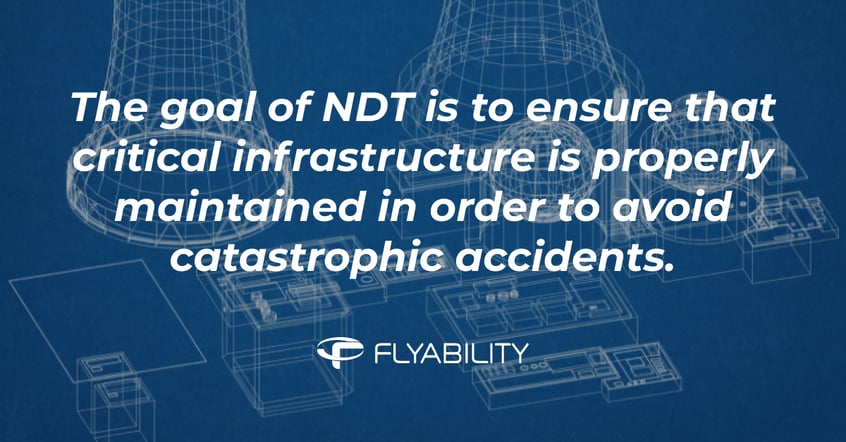
Welding NDT
Welding NDT is the use of non-destructive testing to inspect a weld.
Welds are one of the most common parts of industrial assets that inspectors test. Using non-destructive weld testing equipment, inspectors can determine whether a weld is strong or has potential defects that could compromise its integrity.
The most common flaws found in weld NDT are:
-
Poor weld quality due to the presence of slag
-
Fatigue caused by human error
-
Flaws caused by incorrect technique or setup in how the weld was created
-
Environmental damage to the weld (i.e., temperature extremes, the presence of moisture, or the use of incompatible metals)
The most common welding NDT methods include:
-
Ultrasonic testing NDT
-
Magnetic particle inspection NDT
-
Acoustic emission NDT
-
Dye penetrant NDT
-
Radiography NDT
-
Eddy Current NDT
A visual inspection can be used for weld NDT, to help inspectors make basic determinations about the strength of a weld, though its findings may be more limited than the above welding testing methods.
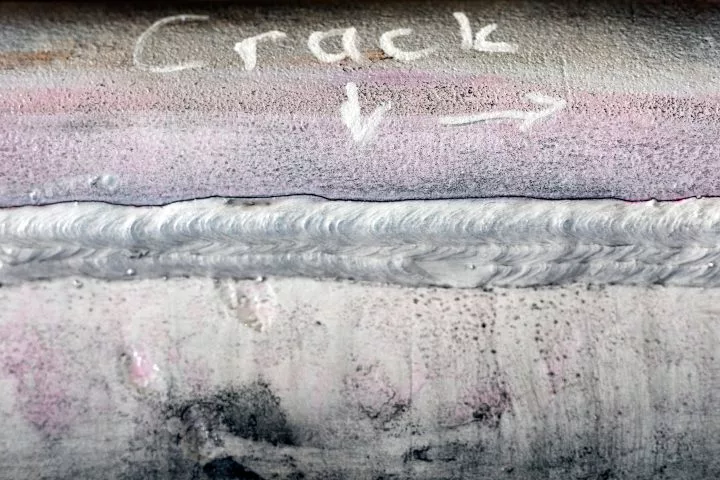 Welding NDT test of a crack performed via magnetic particle inspection
Welding NDT test of a crack performed via magnetic particle inspection
The goal of using NDT for welding is to identify defects on the surface or within the weld that could cause the weld to deteriorate or fail.
If a weld fails, the consequences can be very serious, since welds are often crucial for the integrity of large industrial assets, like boilers or pressure vessels.
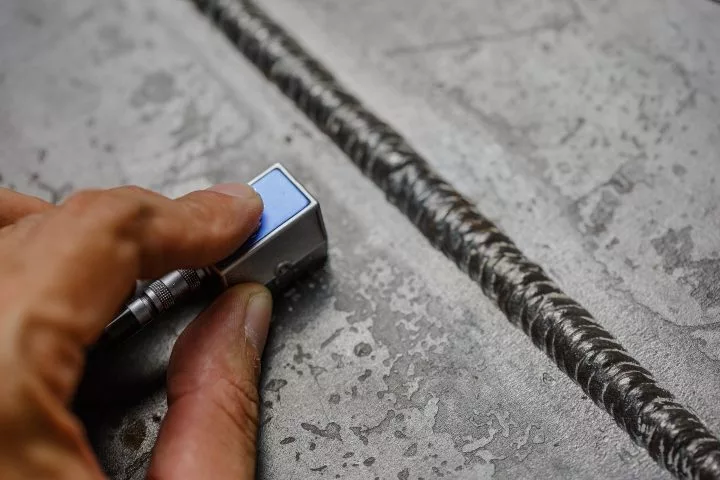
What is the best NDT welding inspection method?
Although all the methods listed above can be used for welding NDT, the best method is ultrasonic testing using the phased array approach.
This welding test method can be done fairly quickly without a lot of setup work required or extra NDT equipment, providing high quality data in a short period of time.
Destructive and Non-Destructive Testing in Welding
We've already covered the primary welding NDT methods, which are inspection methods inspectors use to test weld without causing any damage to them.
But inspectors also use destructive testing to inspect welds.
The most common types of destructive weld testing are:
-
Guided bend weld test. Bending a sample section of the weld to predetermined radius to make determinations about its internal structure.
-
Macro etch weld testing. Removing a small sample from the weld, polishing the samples, then etching on the samples with an acid mixture in order to test the internal makeup of the weld.
-
Transverse tension test. Testing the tensile properties of the base metal, the weld metal, and the bond between them.
How Drones Can Help with NDT
In the last several years drones equipped with cameras have become another tool commonly used in NDT for collecting visual data.
Due to limitations in the technology, for some time drones could only provide supplementary visual data for inspectors, but could not take the place of inspectors physically collecting visual data themselves.
However, as drone technology has improved, inspectors have been able to use drones more and more as RVI tools, in some instances completely replacing the need for them to collect visual data manually.

Here are two of the primary ways drones are helping with NDT these days:
Safety
By removing the need for inspectors to enter dangerous confined spaces in order to collect visual data drones are helping improve safety in the workplace.
For outdoor inspections of assets like power lines or towers, using a drone to collect visual data reduces the amount of time a person needs to physically be in the air on the tower or line.
For indoor inspections of assets like pressure vessels or boilers, using a drone like the Elios 3 to collect visual data means the inspector does not have to enter a confined space to do so, again helping significantly reduce the exposure to risk.
Savings
Drones can help companies improve their ROI in both indoor and outdoor scenarios, but savings are especially significant for indoor inspections.
Using a professional indoor drone instead of sending an inspector in to collect visual data manually means that companies save on not having to build and take down scaffolding, and can reduce downtimes associated with those requirements, in some cases by as much as one to two days.
Because a drone inspection can be mounted quickly, inspections can be conducted more frequently, helping to identify issues earlier and increasing the longevity of the asset. These early discoveries can save companies hundreds of thousands of dollars with a single inspection.

What’s Next for Drones in NDT?
To date, the primary use case for drones in NDT has been for the collection of visual data.
But in the last few years, in addition to cameras, several types of sensors used in NTD have been attached to drones, including thermal, ultrasonic, magnetic, and radiographic sensors.
New sensors supporting NDT methods are constantly being developed for use with drones, allowing inspectors to collect an even wider variety of data without even touching an asset.
In addition, software developed to meet the needs of inspectors is growing in both market and capability. The software can work directly with a drone’s data collection, like Inspector 5.0, the most up-to-date version of Flyability’s inspection software.
Using Inspector, inspectors can quickly create a sparse 3D model of the asset they’re inspecting after the data collection process that shows exactly where defects are located in the asset, successfully addressing a long-time pain point for inspectors. Inspectors can see a defect with the imagery the drone collected and then know where it was using the model's locational information, saving hours of work.
Manually reviewing the mountains of data provided by inspection drones would overwhelm a human. As a result, software designed to help inspectors make sense of the information gathered has become a necessity rather than a luxury.
Aided by machine learning and AI, these advanced programs can process and review images of the asset and flag issues for human review. WinCan, for example, is a company that makes software just for sewer inspections. Using an AI-powered algorithm, its software can take raw visual data from a sewer inspection and identify all of the potential defects that might require further inspection or repair.
Advances in drone technology, payload diversity, and data processing are creating a new era of efficiency for NDT and safety for inspectors.

